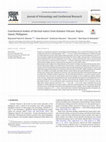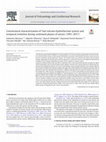Papers by Katharine Maussen
Journal of Volcanology and Geothermal Research
Journal of Volcanology and Geothermal Research

Journal of Volcanology and Geothermal Research, 2019
Kanlaon is a stratovolcano situated in central Negros Island, Philippines. It has a record of 30 ... more Kanlaon is a stratovolcano situated in central Negros Island, Philippines. It has a record of 30 eruptions since 1866 ranging from phreatic to phreatomagmatic (VEI = 1-2) events. Geothermal manifestations in Kanlaon Volcano are evidenced by the presence of hot springs, boiling mud pools, and warm rivers with temperatures up to 95 °C. It has developed a significant hydrothermal system within the volcanic edifice. Through time, it evolved into two distinct hydrothermal systems independent of each other. A mature hydrothermal system, represented by Pataan thermal area is characterized by neutral Na + K chloride (bicarbonate) fluids and an immature system, represented by Hagdan spring is characterized by the presence of acid-sulfate waters. Representative water samples were collected between 2014 and 2017 to further characterize the two systems. Chemical and sulfur isotopic analyses were performed on thermal waters to classify the samples that are linked to the coexistence of these two hydrothermal systems. Results show that thermal spring's pH ranges between 2.5 and 8.1 and conductivity ranges between 88 μS/cm to 3930 μS/cm. Based on their Cl-SO 4-HCO 3 relative abundances, the thermal waters are classified as acid sulfate, acid-sulfate chloride, neutral chloride and neutral bicarbonate waters. Temperatures of deep-water hydrothermal reservoirs were calculated using fluid-mineral geothermometers and correlated with available borehole temperatures. The Na-K-Mg geothermometer was used to evaluate equilibrium between water and reservoir rocks. Results show that the samples are not in equilibrium with the minerals in the reservoir. Temperature of equilibrium for the mature hydrothermal system was extrapolated to 270 °C based on available borehole temperatures. The linear trend towards the equilibrium temperature in the Na-K-Mg geothermometer can be explained by either groundwater/meteoric dilution. This is consistent with the light sulfur isotopic signatures between δ 34 S = −3.4‰ and + 1.2‰ of the mature hydrothermal system (Mambucal), which imply that the origin of sulfates is linked to surficial oxidation of H 2 S or dilution and mixing of meteoric water. On the other hand, immature hydrothermal system (Hagdan) shows a significantly higher sulfur isotopic composition (δ 34 S = +8.2‰), which could either result from the disproportionation of magmatic SO 2 or from the hydrolysis of elemental sulfur at high temperature between 100 and 350 °C.

Taal volcano (Luzon Island, Philippines) has last erupted in 1977 but has known some periods of i... more Taal volcano (Luzon Island, Philippines) has last erupted in 1977 but has known some periods of increased activity, characterised by seismic swarms, ground deformation, increased carbon dioxide flux and in some cases temperature anomalies and the opening of fissures. We studied major, trace element and sulphur and strontium isotopic composition of Taal lake waters and hot springs over a period of 25 years to investigate the geochemical evolution of Taal volcano's hydrothermal system and its response to volcanic unrest.
Long-term evolution of Main Crater Lake (MCL) composition shows a slow but consistent decrease of acidity, SO4, Mg, Fe and Al concentrations and a trend from light to heavy sulphate, consistent with a general decrease of volcanic gases dissolving in the hydrothermal system. Na, K and Cl concentrations remain constant indicating a non-volcanic origin for these elements. Sulphate and strontium isotopic data suggest this neutral chloride-rich component represents input of geothermal water into Taal hydrothermal system. A significant deviation from the long-term baseline can be seen in two samples from 1995. That year, pH dropped from 2.6 to 2.2, F, Si and Fe concentrations increased and Na, K and Cl concentrations decreased. Sulphate was depleted in 34S and temperature was 4 °C above baseline level at the time of sampling. We attribute these changes to the shallow intrusion of a degassing magma body during the unrest in 1991–1994.
More recent unrest periods have not caused significant changes in the geochemistry of Taal hydrothermal waters and are therefore unlikely to have been triggered by shallow magma intrusion. A more likely cause for these events is thus pressurisation of the hydrothermal reservoir by increasing degassing from a stagnant magma reservoir. Our study indicates that new magmatic intrusions that might lead to the next eruption of Taal volcano are expected to change the geochemistry of MCL in the same way as in 1994–1995, with the most notable effects being changes in temperature, pH, F and Si concentrations.
Uploads
Papers by Katharine Maussen
Long-term evolution of Main Crater Lake (MCL) composition shows a slow but consistent decrease of acidity, SO4, Mg, Fe and Al concentrations and a trend from light to heavy sulphate, consistent with a general decrease of volcanic gases dissolving in the hydrothermal system. Na, K and Cl concentrations remain constant indicating a non-volcanic origin for these elements. Sulphate and strontium isotopic data suggest this neutral chloride-rich component represents input of geothermal water into Taal hydrothermal system. A significant deviation from the long-term baseline can be seen in two samples from 1995. That year, pH dropped from 2.6 to 2.2, F, Si and Fe concentrations increased and Na, K and Cl concentrations decreased. Sulphate was depleted in 34S and temperature was 4 °C above baseline level at the time of sampling. We attribute these changes to the shallow intrusion of a degassing magma body during the unrest in 1991–1994.
More recent unrest periods have not caused significant changes in the geochemistry of Taal hydrothermal waters and are therefore unlikely to have been triggered by shallow magma intrusion. A more likely cause for these events is thus pressurisation of the hydrothermal reservoir by increasing degassing from a stagnant magma reservoir. Our study indicates that new magmatic intrusions that might lead to the next eruption of Taal volcano are expected to change the geochemistry of MCL in the same way as in 1994–1995, with the most notable effects being changes in temperature, pH, F and Si concentrations.
Long-term evolution of Main Crater Lake (MCL) composition shows a slow but consistent decrease of acidity, SO4, Mg, Fe and Al concentrations and a trend from light to heavy sulphate, consistent with a general decrease of volcanic gases dissolving in the hydrothermal system. Na, K and Cl concentrations remain constant indicating a non-volcanic origin for these elements. Sulphate and strontium isotopic data suggest this neutral chloride-rich component represents input of geothermal water into Taal hydrothermal system. A significant deviation from the long-term baseline can be seen in two samples from 1995. That year, pH dropped from 2.6 to 2.2, F, Si and Fe concentrations increased and Na, K and Cl concentrations decreased. Sulphate was depleted in 34S and temperature was 4 °C above baseline level at the time of sampling. We attribute these changes to the shallow intrusion of a degassing magma body during the unrest in 1991–1994.
More recent unrest periods have not caused significant changes in the geochemistry of Taal hydrothermal waters and are therefore unlikely to have been triggered by shallow magma intrusion. A more likely cause for these events is thus pressurisation of the hydrothermal reservoir by increasing degassing from a stagnant magma reservoir. Our study indicates that new magmatic intrusions that might lead to the next eruption of Taal volcano are expected to change the geochemistry of MCL in the same way as in 1994–1995, with the most notable effects being changes in temperature, pH, F and Si concentrations.